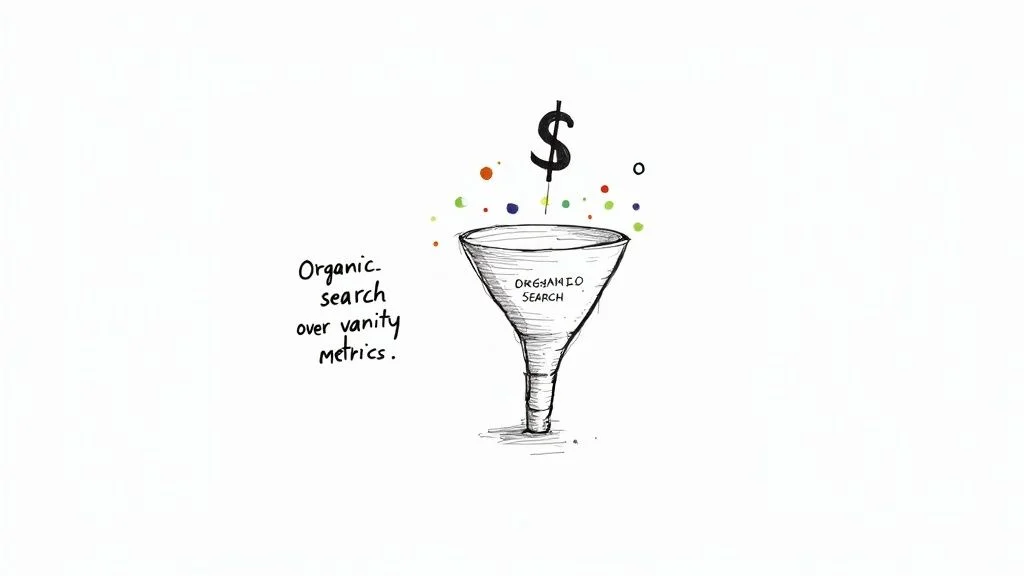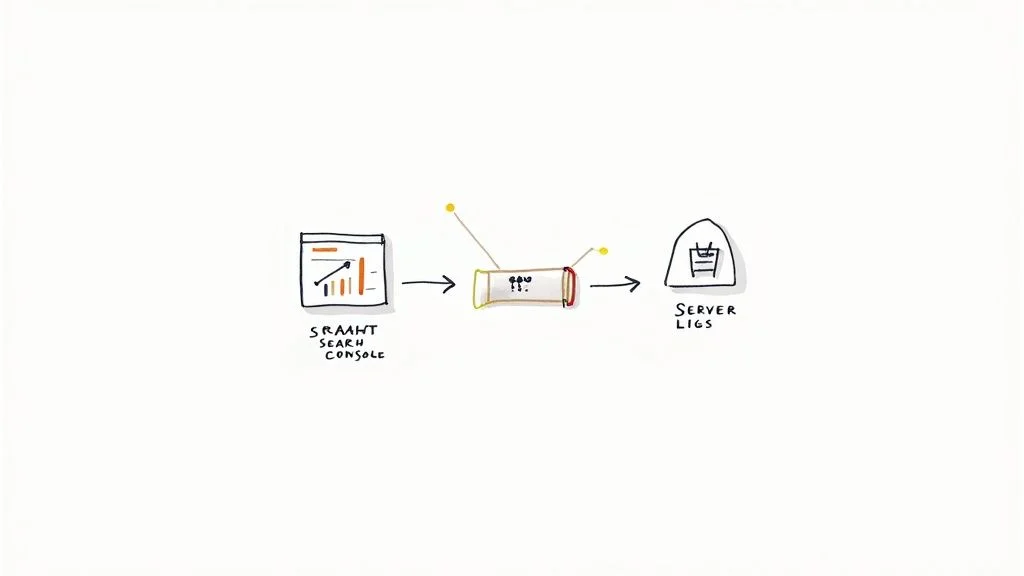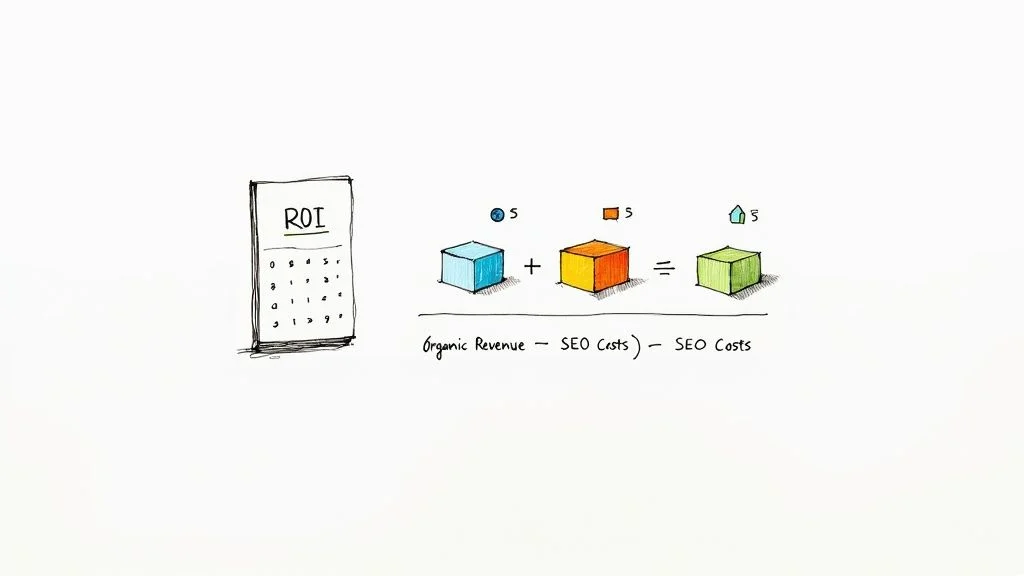
How to Measure SEO ROI and Prove Its True Value
Sections
Let’s be honest, the basic formula for SEO ROI is simple enough: take the money you made from organic traffic, subtract what you spent on SEO, and then divide that by your investment. The classic [(Organic Revenue - SEO Investment) / SEO Investment] x 100 gives you a neat percentage.
But if you really want to prove your worth and get buy-in from the people holding the purse strings, you need to go deeper.
#Defining SEO ROI Beyond Traffic and Rankings

It’s time to cut through the noise. Learning how to properly measure SEO ROI means we have to stop obsessing over vanity metrics like traffic spikes and keyword rankings. Sure, they’re useful health indicators, but they don’t pay the bills. More importantly, they rarely impress stakeholders whose world revolves around the bottom line.
True ROI measurement is all about connecting your organic search efforts directly to business revenue. It’s about reframing SEO from a marketing expense into a powerful engine for financial growth. That’s the language leadership actually understands and cares about.
#Focusing on Business-Centric Outcomes
Forget reporting on a 20% jump in organic sessions. Instead, let’s talk about the numbers that actually drive strategic decisions in the C-suite.
-
Customer Acquisition Cost (CAC): How is SEO lowering the cost to bring in a new customer compared to our paid channels?
-
Revenue Growth: How much new sales revenue can we directly attribute to our performance in organic search?
-
Market Positioning: Are we capturing more market share and strengthening our brand authority through better search visibility?
When you align your reporting with these core business goals, you’re not just a marketer - you’re a critical part of the company’s growth strategy. It’s all about showing how your hard work on the SERPs translates into tangible financial wins.
The goal is to move the conversation from, “We got more clicks this month,” to “Our organic channel generated $X in new business.” This simple shift in framing turns SEO from a cost center into a profit center.
#The Financial Power of Organic Search
So, what kind of return are we talking about? The potential is huge. Recent industry analysis shows that for every dollar invested in a well-executed SEO strategy, businesses can expect an average of nearly $8.50 in net profit.
It gets even better in certain sectors. High-performing industries like real estate and financial services have reported staggering returns of 1,389% and 1,031%, respectively.
This data really drives home why measuring your return accurately is so crucial. It’s what justifies continued investment and secures the resources you need to scale up.
To get there, you need to start with the right data points. Below is a breakdown of the key metrics that truly define SEO success and connect your work to real business impact. You can learn more about which essential SEO metrics to track to get your reporting off the ground.
#Key Metrics That Truly Define SEO Success
Moving past surface-level data is the first step toward meaningful ROI reporting. The table below outlines the metrics that connect your daily SEO tasks to the financial outcomes that matter to business leaders.
| Metric Category | Specific KPI | Why It Matters for ROI |
|---|---|---|
| **Lead Generation** | Organic Lead Volume | Directly measures the number of potential customers SEO is generating. |
| **Conversion Quality** | Lead-to-Customer Rate | Shows how many organic leads are turning into paying customers. |
| **Revenue Impact** | Average Order Value (AOV) | Calculates the average revenue generated per organic transaction. |
| **Customer Value** | Customer Lifetime Value (CLV) | Projects the total revenue a business can expect from a single customer acquired via SEO. |
| **Efficiency** | Cost Per Acquisition (CPA) | Compares the cost of acquiring a customer through SEO vs. other channels. |
| **Visibility** | Share of Voice (SOV) | Measures your brand’s visibility in the SERPs for key topics against competitors. |
By focusing on these metrics, you build a compelling, data-backed story that demonstrates the immense and undeniable value that organic search brings to your organization.
#Laying the Groundwork with Clear Goals and Values

Before you even think about crunching a single number, you need to know what you’re aiming for. Trying to measure SEO ROI without clear goals is like driving without a destination - you’ll collect a ton of data, but none of it will tell you if you’ve actually arrived.
This all starts by turning vague marketing wishes into specific, measurable business outcomes. A goal like “get more organic traffic” is a nice thought, but it’s not a business goal. A real goal ties that traffic to a result, like “generate 150 qualified demo requests from organic search each quarter.”
This simple shift changes the conversation from vanity metrics to real financial impact. To do this right, you need to get comfortable with data-driven decision-making.
#Putting a Price Tag on Every Conversion
Next up, you have to assign a hard dollar value to every meaningful action a user can take on your site. For an e-commerce store, this is easy - the value is just the transaction total. For the rest of us, especially in lead-gen, it takes a little back-of-the-napkin math.
You can’t prove your return if you don’t know what a lead is actually worth. This step is what turns abstract actions, like someone filling out a form, into the cold, hard financial data you need for a credible ROI calculation.
Let’s walk through how a B2B SaaS company would do this:
-
Figure Out Customer Lifetime Value (LTV): First, you need to know the average total revenue one customer generates over their entire time with you. Let’s say your LTV is $10,000.
-
Get Your Sales Close Rate: Grab a coffee with your sales team and find out what percentage of qualified leads turn into paying customers. If they close 1 out of every 10, your close rate is 10%.
-
Calculate the Lead Value: Now for the easy part. Just multiply the LTV by the close rate. In our case, it’s 1,000.
Just like that, every single qualified lead coming from organic search is worth $1,000 to the business. Now you have a real number to build on.
#Picking the KPIs That Actually Matter
With your conversion values locked in, you can now choose the Key Performance Indicators (KPIs) that will be the bedrock of your ROI report. The trick is to pick metrics that directly show progress toward your financial goals, not just traffic charts.
It’s no surprise that a 2025 survey found 49% of marketers named organic search as the channel with the highest ROI, blowing past paid search and social media. This just highlights how critical it is to track the right things to prove that value internally.
Your job isn’t to track all the data; it’s to track the right data. Focus on a few core metrics - like qualified organic leads, assisted revenue from organic touchpoints, and conversion rates on key pages. This brings clarity and stops you from drowning in numbers that don’t mean anything.
Getting this foundation right ensures your entire ROI calculation is built on solid ground. You’ll have clear targets and a bulletproof way to translate clicks and visits into dollars and cents. These are the exact details you’ll plug into your reports, and you can see how they fit into the bigger picture by checking out a solid monthly SEO report template.
#Sourcing and Validating Your SEO Data

Let’s be blunt: your entire effort to measure SEO ROI lives or dies by the quality of your data. A perfect formula is useless if you feed it garbage numbers. That’s why sourcing accurate information and cleaning it up isn’t just a preliminary step - it’s the bedrock of a believable analysis.
The process starts by pulling together the essential pieces of the puzzle. You need to know how many people are coming from organic search, what they’re doing on your site, and which of those actions are actually making you money.
#Your Core Data Toolkit
First things first, you’ll want to head straight to Google’s own powerhouse platforms. They give you the most direct line of sight into your organic performance.
-
Google Analytics 4 (GA4): This is your go-to for understanding on-site behavior. You’ll spend most of your time in the
Traffic acquisitionreport, filtered for the “Organic Search” channel. This is where you’ll see user counts, engagement, and most importantly, the conversion events you set up earlier. -
Google Search Console (GSC): If GA4 tells you what happens on your site, GSC tells you what’s happening in the search results. It’s an indispensable source for impressions, clicks, click-through rates (CTR), and average keyword positions. It perfectly connects your visibility on Google to the actions people take on your website.
If you want to get more comfortable with GSC, our guide on how to use Google Search Console will help you master its reports.
For the more technically savvy, server logs provide the most raw, unfiltered view of your traffic. They record every single request made to your server, including every visit from Googlebot. While digging into logs is more advanced, it can uncover technical SEO gremlins and bot activity that other tools might miss.
#The Critical Importance of Data Hygiene
Pulling the data is the easy part. The real work is making sure it’s clean. Raw traffic data is often packed with noise that can seriously skew your conversion rates and, by extension, your entire ROI calculation. Skip this cleanup, and you might as well be basing business decisions on a fantasy novel.
It’s a classic mistake: celebrating a 15% jump in organic traffic, only to find out half of it was spam bots. This “ghost” traffic never converts, which artificially tanks your conversion rate and makes your SEO look far worse than it actually is.
Think of it like cooking. You wouldn’t just toss unwashed vegetables into the pot. You need to filter out the digital “dirt” before you start your analysis.
#Filtering Out the Noise
To get to a dataset you can actually trust, you need to systematically kick out any traffic that doesn’t represent real, potential customers.
-
Exclude Internal Traffic: Your own team visiting the website can create a surprising amount of traffic, especially in bigger companies. In GA4, you can define your office IP addresses as “internal traffic” and create a filter to block this data from messing up your reports.
-
Identify and Remove Bot Traffic: GA4 has a built-in feature to exclude known bots, but some always slip through the cracks. Keep an eye out for the obvious red flags: sessions with a 100% bounce rate, a time on page of 0 seconds, or traffic coming from bizarre locations.
-
Filter Out Spam Referrals: “Ghost” spam can pop up in your reports, showing you traffic from domains that never actually sent anyone to your site. Create filters in your GA4 property to exclude these known spam domains and keep your referral data clean.
Once you’ve gone through this cleaning process, what you’re left with is a dataset that reflects genuine human interactions. This is the only reliable foundation for calculating your true SEO ROI. It’s the difference between guessing and knowing.
#Choosing the Right Attribution Model
Alright, you’ve gathered and scrubbed your data. Now comes the tricky part: deciding who gets the credit for a conversion. This is called attribution modeling, and it’s precisely where most ROI calculations fall apart.
Think of it as the rulebook for assigning value. When a customer finally makes a purchase or fills out a form, you have to decide which marketing touchpoint deserves the praise. Was it the first blog post they read, the social media ad they saw last week, or the direct search they made yesterday?
The model you pick isn’t just a technicality - it can completely change the story your numbers tell. A bad choice can make your SEO efforts look like a waste of time, while the right one will prove its real value to the business.
#Why Default Models Are a Trap for SEO
For years, most analytics platforms, especially older versions of Google Analytics, defaulted to what’s called a last-click attribution model. This model is brutally simple: it gives 100% of the credit to the very last thing a user clicked before converting.
Sounds fair, right? Not really. Let’s walk through a super common scenario for a B2B software company:
-
A project manager is looking for a solution and Googles “best project management tools.” They find your in-depth comparison article through organic search and spend some time reading it. (SEO does its job!)
-
A week later, they see a retargeting ad for your tool on LinkedIn and click through to check out the features page.
-
Two days after that, they finally decide to act. They type your brand name directly into Google, land on your site, and book a demo.
With last-click attribution, that final “direct” search gets all the glory. The crucial role SEO played in discovering your brand? It gets zero credit. This is a massive problem because SEO is often the workhorse at the top and middle of the funnel, building awareness and trust long before a user is ready to pull out their credit card.
If you’re stuck on a last-click model, you’re basically ignoring all the hard work that filled the pipeline. It’s like giving all the credit for a goal to the player who tapped the ball in, and none to the players who carried it up the field.
#A Look at Smarter Attribution Models
To paint an accurate picture, you have to look beyond the default settings. Different models tell different stories, and the best one for you depends entirely on your business and how long it takes a customer to make a decision.
Let’s break down the main contenders.
-
Last Non-Direct Click: A slight improvement. This model ignores a final direct visit and gives credit to the last marketing channel before it. In our example, the LinkedIn ad would get the credit. Still not great for SEO, but it’s a step in the right direction.
-
First Interaction (First-Click): This is the complete opposite of last-click. It gives 100% of the credit to the very first touchpoint. It’s fantastic for understanding which channels are your best “introducers.” As you can imagine, SEO often looks like a superstar under this model.
-
Linear: This model is the diplomat. It splits credit evenly across every single touchpoint. If a user had four interactions (organic search, social, email, direct), each channel would get 25% of the credit. It provides a balanced view but can sometimes water down the impact of a truly decisive touchpoint.
-
Data-Driven Attribution (DDA): This is the big brain of the group and is now the default in GA4. DDA uses machine learning to analyze countless conversion paths (and non-conversion paths) to figure out which touchpoints actually had the most influence. It’s the most accurate model by far, but also the most complex.
#Making a Conscious Choice
Choosing your attribution model isn’t about picking the one that makes SEO look best. It’s about picking the one that best reflects reality.
If you have a long, complicated sales cycle that can take months (think high-ticket B2B), a first-interaction or data-driven model will give you a much truer sense of SEO’s value. If you’re an e-commerce store with short, impulse-buy sales cycles, last non-direct click might actually be good enough.
The most important thing is to stop using the default just because it’s there. Dive into GA4’s Model comparison report and see for yourself how the perceived value of your organic traffic shifts between models. This single piece of analysis is foundational to calculating a meaningful SEO ROI and finally giving your work the credit it deserves.
#Calculating Your Total SEO Investment and Return

Alright, this is where it all comes together. You’ve defined your goals, cleaned up your data, and picked an attribution model. Now it’s time for the final calculation that turns all that hard work into a single, powerful number revealing the true financial impact of your SEO strategy.
The core formula is pretty simple, but its power lies in the accuracy of the numbers you feed it. To really nail the measurement of your SEO efforts, you need to be precise. For a great refresher on the fundamentals, check out this excellent a step-by-step guide to calculating Return on Investment that breaks down the basics.
#Tallying Up Your Total SEO Investment
First things first, let’s get a real handle on what you’re actually spending on SEO. A huge mistake I see all the time is people only counting the most obvious expense, like an agency retainer. That will seriously inflate your perceived ROI and give you a skewed picture. To do this right, you have to be meticulous.
Your total investment is the sum of every direct and indirect cost. Think beyond the big-ticket items and account for every resource that fuels your organic search performance.
Your cost breakdown should include things like:
-
Agency or Freelancer Fees: This is the easy one - what you pay any external partners for their SEO services.
-
In-House Team Salaries: Be honest about how much of your team’s time is dedicated to SEO. If a content writer spends 50% of their time on SEO-focused articles, you need to include half their salary in your calculation.
-
Tool Subscriptions: Add up the monthly or annual costs for all your SEO software. We’re talking about tools like Ahrefs, Semrush, or any rank trackers you use.
-
Content Creation Costs: Any budget set aside for freelance writers, graphic designers, or video production that’s specifically for SEO content goes here.
-
Link Building Expenses: This includes any direct costs tied to digital PR campaigns, outreach efforts, or sponsored content you’re using to earn backlinks.
To help you organize this, here’s a simple way to look at it.
#Example Breakdown of Monthly SEO Costs
This table gives you a sample of how to aggregate your SEO expenses to get an accurate total investment.
| Expense Category | Monthly Cost Example | Notes |
|---|---|---|
| SEO Agency Retainer | **$5,000** | The primary fee for comprehensive SEO services. |
| In-House Salaries | **$2,500** | Represents 50% of a content manager's salary. |
| SEO Software | **$500** | Combined cost for Ahrefs, a rank tracker, etc. |
| Freelance Content | **$1,500** | Budget for 4 blog posts per month from a freelancer. |
| Link Building Outreach | **$500** | Costs for a part-time outreach specialist or specific campaigns. |
| **Total Monthly Cost** | **$10,000** | The complete figure to use in your ROI calculation. |
Adding these up gives you the “Total SEO Costs” part of our equation - a number that’s actually grounded in reality.
#The Core SEO ROI Formula
Now that you have your total costs and your organic revenue figured out from the previous steps, the math is straightforward. The formula to calculate SEO ROI is:
(Organic Revenue - Total SEO Costs) / Total SEO Costs
The result will be a decimal. Just multiply that number by 100 to express it as a percentage. A positive percentage means you’re in the green, while a negative one shows a loss.
#Putting It All Together with an Example
Let’s walk through a real-world scenario. Imagine a local plumbing company wants to measure their SEO ROI for the last quarter.
-
Quarterly Organic Revenue: They’ve assigned a value of 60,000.
-
Quarterly SEO Costs: Their agency costs 15,000 for the quarter), plus they spent 1,500 on blog content. That brings their total costs to $17,000.
Now, let’s plug those numbers into the formula:
-
( 17,000 ) / $17,000
-
17,000 = 2.53
-
Multiply by 100 to get the percentage: 253% ROI
This is the kind of result that gets attention. It clearly shows that for every 2.53 in profit. This is how you justify budgets and prove your worth.
#Thinking Long-Term with Customer Lifetime Value
While this calculation is perfect for a specific period, a more advanced approach looks beyond a single conversion.
Bringing Customer Lifetime Value (LTV) into the mix paints a much more complete picture of SEO’s long-term impact. A customer you acquire through SEO today might generate recurring revenue for years, and your ROI reporting should absolutely reflect that future value. It’s the difference between measuring a single battle and understanding who won the war.
Got a solid framework? Great. But when the rubber meets the road, a few tricky questions always pop up. It’s these little details that often trip people up, so let’s get straight to the point and tackle the most common ones I hear.
#How Long Does It Really Take to See an SEO ROI?
You have to play the long game here. Realistically, you’re looking at a 6 to 12-month window before you start seeing a positive return on your SEO investment.
Of course, this isn’t set in stone. The timeline can shift depending on how competitive your market is, your website’s authority right now, and how aggressively you’re pushing your strategy.
For instance, some quick technical SEO wins might start showing results in around six months. But for the big, needle-moving strategies - like building out content hubs and earning quality backlinks - you’ll often need a full year or more for them to really cook and deliver a serious financial return. SEO has compounding value; it’s not a switch you can just flip for instant results.
#My Business is All About Leads. How Do I Measure That ROI?
This is a classic one for businesses that don’t sell directly from their website. The key is to stop thinking about leads as just form fills and start assigning them a hard monetary value.
Here’s the simple math: multiply your lead-to-customer conversion rate by your average customer lifetime value (LTV).
Let’s walk through an example. Say your sales team is fantastic and closes 10% of all qualified leads that come through the website. And let’s say your average customer LTV is a healthy 500 ($5,000 x 0.10). Now you can track every form submission or tracked phone call from organic search and tie it directly to revenue.
This one step is what separates professional ROI tracking from amateur hour. It turns abstract clicks into the cold, hard financial data you need to prove your case. Without it, you’re just counting vanity metrics with no real connection to the P&L.
#Should I Bother Separating Branded and Non-Branded Traffic?
Yes. One hundred percent. You absolutely have to.
Why? Because separating your branded traffic (people searching for your company name) from your non-branded traffic is the only way to truly understand how SEO is driving new customer acquisition. People searching your brand name already know you exist. The real power of SEO lies in capturing the attention of people who have never heard of you before.
It’s easy enough to do in Google Search Console. Just apply a filter to your performance reports to exclude any search queries that include your brand name. This isolates the traffic - and revenue - generated purely from non-branded keywords, giving you a crystal-clear picture of how SEO is actually growing your audience.
Ready to stop guessing and start measuring with precision? Rankdigger pulls your Google Search Console data directly, helping you pinpoint high-opportunity keywords and track the real-world impact of your SEO efforts. Start making data-driven decisions today at https://rankdigger.com/en.

